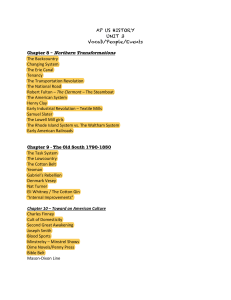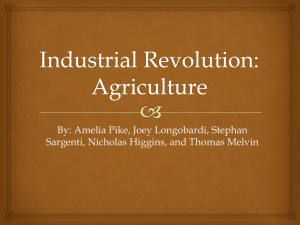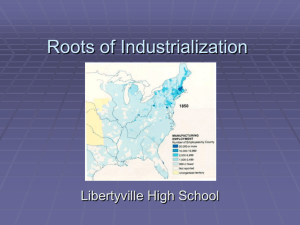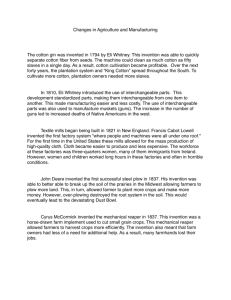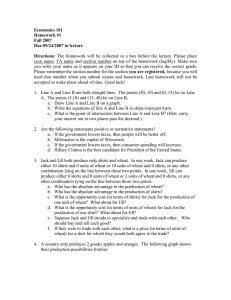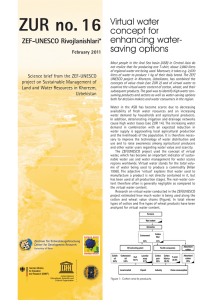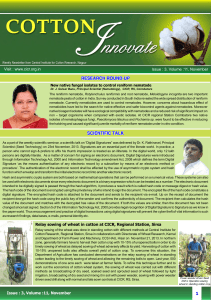CHAPTER 11
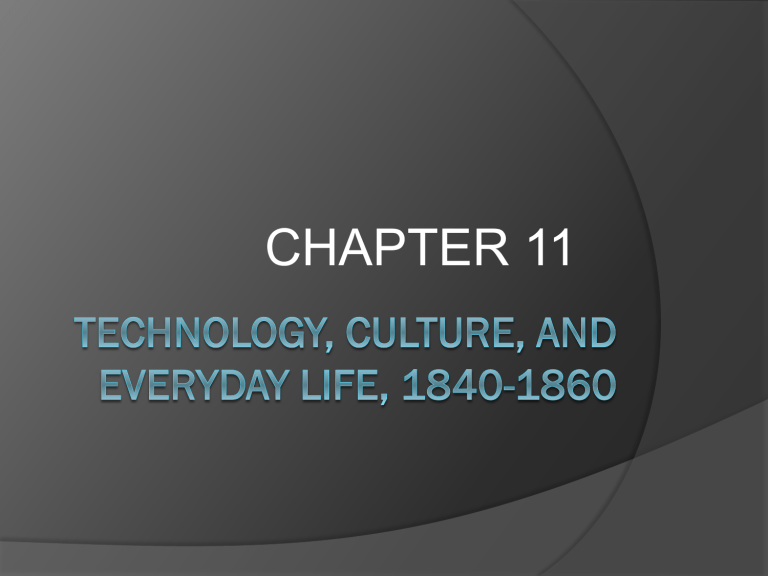
CHAPTER 11
Introduction to Ch. 11
Stitching by hand
Pants – 3 hrs.
Dress – 7 hrs.
Stitching by machine
Pants – 38 mins.
Dress – 57 mins.
700-800 machines per year (1851) to
21,000 (1859) to 174,000 (1872)
Installment plans were adopted by Singer
Most machines were sold to factories
There was an upbeat response to technological change (God’s chosen instrument of progress)
Yet there was a darker side
Revolvers kill
Sweatshops formed
The urban decay
Hailed as democratic, the benefits of technology drew praise from all sides
Antebellum life was transformed
Steam engine, cotton gin, reaper, sewing machine, telegraph
Transportation and production increases
= lower commodity prices
Agricultural Advancement
Westward expansion = opportunity for innovation and increase in production
John Deere’s steel-tipped plow busts up
Midwestern soil, opening it up to wheat
Available timber builds homes and fences
Wheat is the Midwestern cotton
Agriculture innovations meet business enterprise
Cyrus McCormick’s offers deferred payments and money back guarantees
The Reaper harvested grain 7X faster with ½ the labor force
He sells 80,000 in 1860; 250,000 during the Civil War
Interesting
Whitney (Conn. Yankee) helped the South
○ Solidified Cotton as King and made it more profitable
McCormick (Virginia Confederate) helped the North
○ North was the main market for the wheat and freed up workers to join the army
West was not conscientious of farming innovation yet
The East was much better – in an effort to compete with the amount coming out of the West
Plaster in Virginia
Guano in southern cotton
Technology and Industrial
Progress
American System
Interchangeable parts made American manufacture distinct
○ Replacement parts available
○ Enabled entrepreneurs to push inventions swiftly into mass production
Examples: Smith and Wesson from Colt; telegraph lines put up quickly to tackle fire communication
The Railroad Boom
Americans were travelling first class
(those allowed to ride)
Problems though
No brakes or lights, problems in scheduling and delays, and different gauges gradually give way to better conditions
Important: RR connects the East to the
Midwest
Chicago replaces New Orleans as the interiors commercial hub
They also propels the growth of small towns on their route
Example: Illinois Central
Roads going E-W trees; N-S numbers
Land speculation along the lines was big time
Important to understand about the RR
Government financing contributes to private investment
Railroad financing and investing helps make the NYSE and New
York what it becomes
Rising Prosperity
From 1800 to 1850 prices drop and worker’s real income increases 25%
More work available all year long
Women and children contribute more (they have to)
Commodity prices fall
Despite some of the problems in quality of life in the cities, most in rural areas did not own farmland, etc.
Mixed messages on which is better
Quality of Life; Dwellings,
Con/Incon.
Patent offices flooded
Machine-made furniture provide taste; stoves provide heat; RR provide fresh food
The middle class may be a bit closer to the upper, but they both separate from the lower
Rowhouses and tenements vs. “Place” and
“Square”
Running water and burning coal
Baths, sewage, and hogs
Disease, Health, and Movements
Transportation increased spreading
Public calls for municipal health boards
Little confidence in conclusions of medical professionals
Contagion vs. miasma theories
Anesthesia helps improve image
Phrenology – example of invented science that improves simple
“understanding”
Newspapers
1830 – newspapers were 4 pages long with a circulation of 1,000-2,000
Journalists were loyal to some clique
Steam-driven cylindrical presses change everything
(10X increase)
Newspaper now relied on circulation, not political subsidies
1833- the Penny Press
So common newsboys sell on the streets
Topics become human-interest stories with actual reporters
New York Tribune and New York Herald
The Theater
All classes went to the shows
They were notoriously rowdy (prostitutes, etc.)
Most of the shows were Shakespearean, dumbed down for understanding and maybe even altered a bit
Short performances took up the interludes
Minstrel Shows
Plays much into the American sense of racial superiority by diminishing blacks
Especially that of working-class whites
Blacks were docile, dancing around, stumbling over words, etc.
Songs such as “Dixie”, “Camptown Races”,
“Oh Susannah”, “Old Folks Home” and
“Carry Me Back to Old Virginny” started out as songs in minstrel shows.
P.T. Barnum
Recognized the opportunity to make money off of entertainment
He was a hustler
He bought an old museum, called it the American Museum, and created popular entertainment
Main goal was to prick public curiosity
Strong lecturer on the temperance circuit
He helped break down barriers that divided the pastimes of husbands and wives
Roots of American Renaissance
What helped create this development?
Transportation innovations created a national market for books
The rise of philosophical movement known as
Romanticism
○ it challenged the classical view of “standards of beauty being universal”
○ Also, it focused on the emotionally charged
The democratization of literature had begun
Writing fiction was the new genre
It did not require knowledge of Latin or
Greek
The novel allowed for interpretation
James Fenimore Cooper
Created the distinctively American character,
Natty Bumppo (Leatherstocking)
Ralph Waldo Emerson
Most influential spokesman for American
Literary Nationalism
Transcendentalism – our ideas of God and freedom are inborn; knowledge resembles sight- an instantaneous and direct perception of truth
The American Scholar
Walt Whitman
Influenced by journalism and politics – kept him in touch with ordinary Americans
Leaves of Grass (shattered poetic conventions)
Henry David Thoreau
Rep. of the younger Emersonians
More action oriented
Civil Disobedience; Walden
